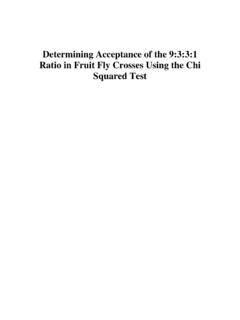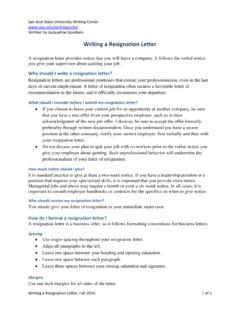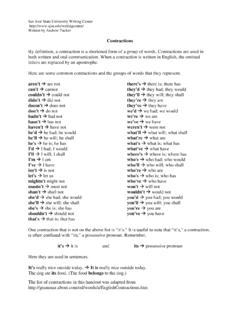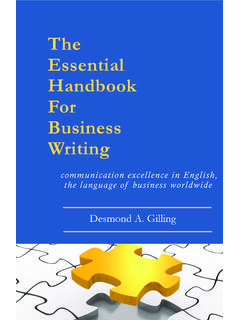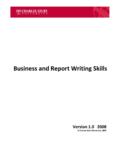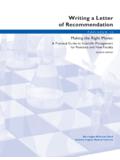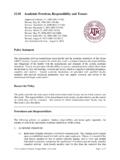Transcription of WRITING PROFESSIONAL LETTERS - University of …
1 WRITING PROFESSIONAL LETTERS The need for effective oral and written communication skills is becoming increasingly important in the work force. Therefore, it is critical that as a candidate you are able to write PROFESSIONAL LETTERS throughout your job search to effectively market yourself to potential employers. Structure of Effective LETTERS There is an acceptable structure for WRITING PROFESSIONAL LETTERS as noted in the guidelines below: Your return address and the current date needs to be placed at the beginning of the letter - either top left corner, tabbed or flushed right in the upper right-hand corner of the letter . Do not include your name or telephone number in this section. The employer s address should be placed at the left margin before the salutation. The inside address includes the name, title, department, and complete address of the organization to whom you are WRITING . The salutation is the formal greeting of the letter . Dear Mr. or Dear Ms.
2 Preceding the individual's last name is appropriate. The punctuation following the salutation can be a colon (:) or comma (,). Do not use Mrs. unless you have seen this title used by the individual in question. Do not use To whom it may concern or Dear Sir/Madam as it will appear you have written a form letter . If you do not have the name of an individual, you may use Dear Human Resources . The body of the letter comes after the salutation. The body can be three to five paragraphs in length depending upon the content and intent of the letter . Paragraphs can be indented five spaces or block style can be used. The text within each paragraph is single-spaced with double-spacing between each paragraph. The closing follows the body of the letter . It is aligned with your return address and current date that opened the letter . A formal closing, such as "Sincerely," is appropriate. Three to four blank lines are inserted and type your formal name as it appears on your resume.
3 Above your typed name, sign your name in blue or black ink. Other colors of ink and pencils will not photocopy well. If information is to be enclosed, ( a resume or transcript) then it is appropriate to place the word "Enclosure:" at the left margin followed by the name(s) of the document(s) enclosed. Tips for WRITING High Impact LETTERS LETTERS should not exceed one page in length. Do not send "form LETTERS ". To make a positive, PROFESSIONAL impression, you should make the effort to personalize and tailor each letter to a specific employer. Be sure to use a high quality, 8 by 11 bond paper. It is best to use the same paper on which your resume was printed. Your cover LETTERS must be error-free. Be sure to proof-read each letter for typographical, spelling, punctuation and grammatical errors. Have others read your LETTERS for clarity and to check for errors. All LETTERS should be typed and printed on a laser-jet printer.
4 Hand-written LETTERS or notes are unacceptable. Neatness counts and so does attention to detail. If you are concerned about damage to your documents, you may want to use a full size manila envelope for mailing. Remember that a PROFESSIONAL appearance is important. Be sure to type the return and mailing address directly onto the envelope or onto a label. In some cases you may be sending your documents to employers by e-mail. Be certain that you keep this correspondence PROFESSIONAL in manner and follow the same guidelines provided regarding letter content and structure. The following descriptions represent the types of LETTERS that you might find appropriate at various stages of your job search. A sample of each type of letter is enclosed for your review. letter of Inquiry During your job search, you might encounter times when you are in need of information about an organization, a specific position or geographic location.
5 In this case, you would write a letter of inquiry. In the letter , you request the information needed. A letter of inquiry is sent by itself. Your resume should not be enclosed. This can hurt your candidacy if you should contact the same organization in the future. Remember, this is not an application letter . Even though you are requesting information from the organization, it may be appropriate to share information about yourself and your strengths. Remember that it should be provided in the context relevant to the information requested. This may be your first contact with a potential employer. Therefore, it is critical that this letter be well-written and targeted to the organization in question. Often times organizations cannot immediately respond to various requests. You should close your letter by stating your intended method and time line for follow-up. Then be sure to carry out your actions. NOTE: Due to legal issues, many employers will not accept unsolicited resumes and letter .
6 If you are inquiring about job listings or the application process, it is suggested to view the employer website, and if you do not see a "Jobs" or "Career" section of the site, call or e-mail to find out where openings are listed. With on-line applicant systems, individuals may be able to apply for positions without seeing specific positions listed. Students often ask if they will receive acknowledgment by the employer after sending a letter of inquiry. Be aware that since you will be sending an unsolicited letter , you may or may not receive a response. However, these LETTERS do demonstrate to an employer that you are taking a planned, organized approach to your job search. This can be impressive and encouraging to employers. letter of Application When you send a resume to an employer it must be accompanied by a letter of application, also known as a cover letter . This letter is essential. The purpose of the cover letter is to highlight the skills, education and experience you possess related to their position.
7 You will express to an employer why you are interested in the position and what contributions you believe you can make to the organization based upon your qualifications. Since the cover letter is the ideal place to focus on the specific skills you want to emphasize for a particular employer, a unique cover letter must accompany each resume you send. Be sure to introduce yourself, the position for which you are applying and identify the source that listed or advertised the position opening. If you were referred to the position by a specific individual, make note of that in your letter . The letter should be addressed specifically to the person (by name and title) who will be conducting the screening process and/or interviews. You can generally find out this information by calling the human resources department of the organization. The objective of this letter is to highlight your skills and experience in relationship to the needs of the employer to whom you are WRITING .
8 Each letter of application you write will be different based upon the position requirements and functions, focusing on the skills that are important to that particular employer. Be sure to indicate your willingness to discuss the position further and to be available for an interview. If you have been asked to provide salary requirements, you may note this in the last paragraph of your letter . An example: With regards to salary expectations, I would hope to be compensated in the range of $XX,000 to $XX,000 based upon my education and experience. Be certain to research what salaries are typical for your career field! If you are applying for a position through an on-line application system, there may be a section in which you can copy & paste or upload a cover letter . If there is not a designated space, you may include your cover letter information in the "Additional Information" section if one is provided. Pre-Interview and Pre-Screening letter An opportunity might arise where it is necessary to write a letter to an on-campus recruiter or job fair employer in order to secure an interview.
9 Similar to a letter of application, the purpose of the letter is to highlight your qualifications and career interests to the employer. Explain your purpose is to request an interview with the organization. Consider the organization's employment needs and demonstrate how your career goals and qualifications match their needs. Enclose a resume for the purpose of screening. This is appropriate considering that you are referring to a specific position. Close the letter firmly by requesting the future interview or meeting. Interview Confirmation letter Once your application has been screened by an employer, you may be granted an opportunity to interview with the organization. This interview could be a site visit, a telephone interview, or on-campus interview. If time permits, you may wish to confirm the arrangements made for the interview. This demonstrates to a prospective employer that you are organized, responsible, and concerned about the details of the interview.
10 Review the arrangements made for the interview. Be sure to include the time, date and location of the interview. Refer to important information that you were asked to bring to the interview or complete in advance such as a pre-employment exam, employment application, or official transcripts. Restate your appreciation for the employer's consideration of your qualifications and the opportunity to interview. Post Interview Thank You letter It is strongly recommended to send a thank you letter promptly after each interview. This can reinforce or leave a favorable impression on an employer, especially because so few candidates take the time to send them. Given that some employers may be making interview or hiring decisions in a relatively short time-frame, you may wish to e-mail your thank you letter , which is acceptable. A point to keep in mind is that the longer you wait to send a thank you letter , the less impact your letter will have on the employer.


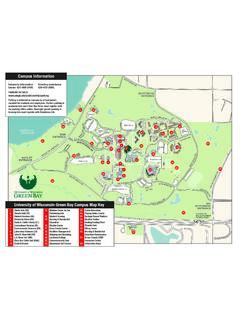


![[draft] MINUTES 2021-2022 UW-GREEN BAY FACULTY …](/cache/preview/0/6/a/4/0/2/1/8/thumb-06a40218c6d824ef545732c5e83fb1fc.jpg)


